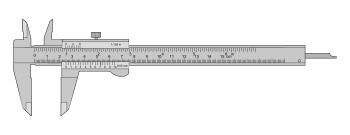Pierre Vernier

Pierre Vernier (French pronunciation: [pjɛʁ vɛʁnje]; 19 August 1580 at Ornans, Franche-Comté (at that time ruled by the Spanish Habsburgs, now part of France) – 14 September 1637, same location) was a French mathematician and instrument inventor. He was the inventor and eponym of the vernier scale used in measuring devices.
Life
[edit]
He was born in Ornans, France, in 1580. He was taught science by his father. He became captain and castellan of the castle at Ornans, for the King of Spain. He was also later councillor and director general of economy in the County of Burgundy.
In Brussels, in the year 1631, Vernier published his treatise La construction, l'usage, et les propriétés du quadrant nouveau de mathématique, and dedicated it to the Infanta. In it, he described the ingenious device which now bears his name, the vernier scale.[1][2]
To a quadrant with a primary scale in half degrees Vernier proposed to attach a movable sector, thirty-one half degrees in length but divided into thirty equal parts (each part consisting then of a half-degree plus one minute). In measuring an angle, minutes could be easily reckoned by noticing which division line of the sector coincided with a division line of the quadrant.
Christopher Clavius had earlier mentioned this idea but had not proposed to attach the scale permanently to the instrument.[3]
The name vernier is now applied to the small movable scale attached to a caliper, sextant, barometer, or other graduated instrument and was given by Jérôme Lalande. Lalande showed that the previous name, nonius after Pedro Nunes, belonged more properly to a different contrivance.[4] The name nonius continued to be applied to the vernier until the beginning of the 19th century.[5]
Notes
[edit]- ^ Chisholm 1911.
- ^ Vernier, Pierre (1631). La Construction, l'Usage et les Propriétez du Quadrant Nouveau de Mathématique [The Construction, Use, and Properties of the New Mathematical Quadrant] (in French). Brussels, (Belgium): Francois Vivien.
- ^ Clavius, Christopher (1604) Geometria Practica (in Latin) Rome, (Italy): Aloisii Zannetti. Book 1, chapter 2, pp. 15–19. See especially the illustration on p. 16. From p. 15: "Constructio quadrantis, in quo minuta quoque, ac secunda deprehendantur, etiam si gradus in ea secti non-sint. Et quo pacto eadem minuta & sec. obtineri possint in quadrante in 90 gradus distributo. Ac denique qua ratione ex data recta in paucissimas partes aequales divisa abscindi possint partes millesimae, etc." (The construction of a quadrant in which any minute and second [of arc] are observed, even if they are not divided into those graduations. And where fixed, the same minute and second may be able to be obtained on a quadrant [that has been] divided into 90 degrees And furthermore by the same reasoning, from a given straight [line], they may be able to be divided into the smallest, equally divided parts (thousandths, etc.).)
- ^ de la Lande (1764). Astronomie (in French). Vol. 2. Paris, France: Desaint & Saillant. p. 859. From p. 859: "La division qui est aujourd'hui la plus employée est appellée dans plusieurs Auteurs division de Nonnius, quoique Nonnius n'en soit pas l'Auteur; mais il en avoit imaginé une autre qui eut beaucoup de célébrité, & qui pouvoit conduire à celle que nous avons aujourd'hui. Le véritable Auteur de la nôtre fut Pierre Vernier qui la publia dans un petit Ouvrage imprimé à Bruxelles en 1631." (The scale which is most used today is called by many authors "Nonnius' scale", although Nonnius is not the inventor of it; but he had imagined another one which was very well known and which could have led to what we have today. The true inventor of our [scale] was Pierre Vernier who published it in a small work in Brussels in 1631.)
- ^ Daumas, Maurice, Scientific Instruments of the Seventeenth and Eighteenth Centuries and Their Makers, Portman Books, London 1989 ISBN 978-0-7134-0727-3
References
[edit]- Chisholm, Hugh, ed. (1911). . Encyclopædia Britannica. Vol. 27 (11th ed.). Cambridge University Press.
- Linehan, Paul Henry (1912). . In Herbermann, Charles (ed.). Catholic Encyclopedia. Vol. 15. New York: Robert Appleton Company.
External links
[edit]- O'Connor, John J.; Robertson, Edmund F., "Pierre Vernier", MacTutor History of Mathematics Archive, University of St Andrews
| International | |
|---|---|
| National | |
| Other | |
Text is available under the CC BY-SA 4.0 license; additional terms may apply.
Images, videos and audio are available under their respective licenses.
